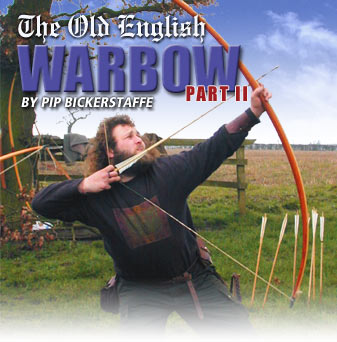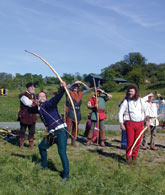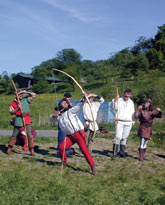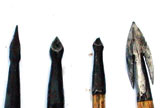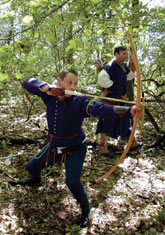|
We have a number of English Yew staves that are as good as it gets, and the first of these should be a working bow in the near future, I am keen to see how well it can perform and have my own private little wager on how it might compare. We’ll all have to wait and see.
Now a little plea from the heart to you all, the readers of this fine magazine. Are there any bowyers out there in Italy who may be able to supply me with a yew stave of the size and quality of those used to build the original Tudor Mary Rose bows? Whilst the tests that we are doing are very interesting and useful it would be good to match, as accurately as possible, the original equipment in order to be able to be as certain as possible of the true capabilities of these bows. Was this wood as good as or better than Oregon Yew when used to build these big bows? Nobody seems to be able to answer this question, why not see it answered first in Primitive Archer!
On a dull wet and windy day Mark, Jez and myself spent some
time comparing the new yew bow with a hickory backed yew bow with a wide range of replica arrows. These results are a comparison of bows and arrows. Though, in these less than ideal conditions, the distances are by no means as good as they can be. Perhaps this is no bad thing as I’m sure that none of the crucial battles were fought in ideal conditions either!
We used six different types of arrows, described later, in groups of three of each in order to give an average result to iron out the very good or very bad shots. The actual results, on the ground, were encouraging as each type of arrow formed a reasonably tight group with the others of the same type.
Jez, a new recruit to this little venture, was shooting a new hickory-backed yew bow, which was heavier than he is used to, but we should soon begin to see some good results from Jez as he gets to grip with it.
Mark shot all of the arrows from both of the bows at both 28 and 32 inches to give comparative results for archers of different stature who would have each been supplied with “standard military issue” sheaves of arrows.
The following tables give the results achieved and details of the different arrows used:

(click to see the chart)
For the future not only do we hope to add an English Yew bow to the testing, and maybe an Italian Yew bow, we shall endeavor to give both the speeds of the arrows as they leave the bow but also the speeds at different distances, including the terminal velocity as the arrows strike the ground This is not going to be easy but we think that we may have it cracked with the design of a laser scanning chronograph that we are building with help from Gwyn, a new member of the team. The future of this project is exciting and should provide us with the data from which we can determine just what the penetrative power of a typical war arrow might be at 200+ yards. It is not hard to do this at close range but to work this out for the terminal velocity needs data that nobody has ever gathered before. Space-age technology applied to primitive technology! We may just find out that primitive technology was more effective than many people realize, I’m really keen to find out.
Results
The results, so far, are both misleading and interesting. Generally the self yew bow is shooting slightly farther than the hickory-backed yew bow, as we might expect it to. There are a couple of results that do contradict this though. Bearing in mind the weather conditions at 6.5 - 7 degrees centigrade, 55 percent humidity, a 10-15 mph variable crosswind from left to right and the fact that in these conditions muscles tire quicker and recover slower, it would be unwise to read too much into this but to view the whole of the results, so far, as being a “general guide” more than anything else.
What we can see is that a heavier arrow with big fletchings will travel almost as far as an arrow around half it’s weight with smaller fletchings. Without doubt either could kill a man at this distance, though the heavier arrow would stand a far better chance of penetrating armour than the lighter one. The extra 20 or so yards from the bearing arrow would be enough to reach and affect an army who might believe that they were “out of range,” a morale destroyer more than a creator of casualties perhaps.
The English artillery bow was intended to put heavy projectiles into an opposing army to devastating effect before they could bring their better equipped, and often bigger, army into play. The advantage that these bows gave our armies allowed us to win battles where we had no right to win if you simply take the numbers on each side into account. There is much more that we can learn about this subject and you will get to see it all here first in Primitive Archer as the results come in. Between us a much clearer picture of how this crucial weapon, in its own niche in time, influenced our history.
|
